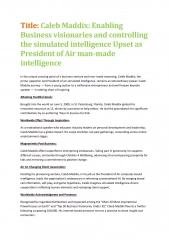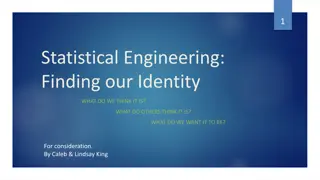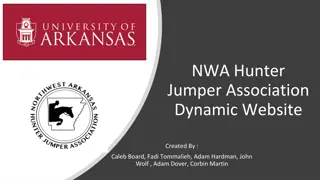
English Genitives in Coordinate Structures
Explore the complexities of English genitives in coordinate structures through an examination of pronominal, prenominal, and oblique forms, highlighting distinctions in clitics vs. affixes and structural vs. non-structural cases. Discover proposed solutions to grammatical challenges in these constructions.
Download Presentation

Please find below an Image/Link to download the presentation.
The content on the website is provided AS IS for your information and personal use only. It may not be sold, licensed, or shared on other websites without obtaining consent from the author. If you encounter any issues during the download, it is possible that the publisher has removed the file from their server.
You are allowed to download the files provided on this website for personal or commercial use, subject to the condition that they are used lawfully. All files are the property of their respective owners.
The content on the website is provided AS IS for your information and personal use only. It may not be sold, licensed, or shared on other websites without obtaining consent from the author.
E N D
Presentation Transcript
ENGLISH GENITIVES IN COORDINATE STRUCTURES Caleb Feltis University of Minnesota
2 Introduction Consider (1) John and Mary s table is very big. (2) John s and Mary s tables are very big. (3) */??My and Mary s tables are very big. (4) */??Mine and Mary s tables are very big. (5) */??Me and Mary s table is very big. (6) */??Your and my tables are very big. R-expressions are fine in coordinate genitive structures, but pronouns show a resistance To complicate the problem further, the unexpected acceptability of (7) His and Mary s tables are very big. R- Exp Pro R- Exp * Pro * *
3 Roadmap To propose one possible solution I will claim the following: There are three forms of genitive in English: Pronominal: my book Prenominal: John s book Oblique: the book of John s (Payne 2013) These distinguish themselves from one another via a clitic vs affix distinction and a structural vs non-structural case distinction. Coordinate structures are formed cyclically (following Wagner 2010) and these cyclic spell-outs assign the oblique genitive to their coordinate. The ungrammaticality of these sentences come from 1) a double case assignment, 2) a coordinate phrase not marked for case, or 3) a coordinate mismatched for the case of its coordinate phrase
4 Clitics vs Affixes Clitics are syntactically distinct nodes, albeit phonologically dependent Affixes are morphological The oblique and pronominal genitive are examples of affix, the prenominal genitive is a clitic, under Carstair s (1987) criteria
5 Structural vs Non-structural case The oblique and pronominal genitive are examples of affix, the prenominal genitive is a clitic There is another distinction to be made: case The pronominal genitive has non-structural case: it comes into the syntax already marked for +GEN The prenominal and oblique genitive have structural case: they receive their case from the syntax Pronominal (my table) Non-structural Affix Prenominal (John s table) Structural Clitic Oblique (table of John s) Structural Affix Case Clitic/affix
6 Clitics vs Affixes (9) John s table (clitic, structural case) (8) My table (affix, non-structural case) In both (8) and (9), the D head has an EPP feature which demands the spec position be filled by something marked for +GEN.
7 Clitics vs Affixes (9) John s table (clitic, structural case) (10) This table of John s (affix, structural case)
8 Coordinate Structures Consider (11) a. This is John, Tom, and Mary s table. b. This is John and Tom s | and Mary s table. c. #This is John and Tom | and Mary s table. The different prosodic boundaries not only have different interpretations, but it appears as if the s is mandatory before a boundary I propose this s is the oblique genitive, same as this table of John s
9 Coordinate Structures Following Wagner (2010) Cyclic analysis of coordinate structures (12) Two apples were given out, but I don t know to whom. Who was given an apple? a. Lysander | and Demetrius || and Hermia respectively b. Lysander || and Demetrius | and Hermia respectively c. # Lysander | and Demetrius | and Hermia respectively Wagner s theory is composed of two assumptions (13) Strong Right-Branching Conjecture In a given work-space, grammar only generates right- branching structures. (14) The Recursive Step Each output can re-enter a new work-space to build a bigger expression.
10 Coordinate Structures (15) Lysander | and Demetrius | and Hermia
11 Coordinate Structures (16) Lysander || and Demetrius | and Hermia
12 Coordinate Structures (17) Lysander | and Demetrius || and Hermia
13 Coordinate Structures Recall the original problem (18) a. This is John, Tom, and Mary s table. b. This is John and Tom s | and Mary s table. c. #This is John and Tom | and Mary s table. This can now be explained relatively straight-forwardly under Wagner s analysis We see that the prosodic boundaries are necessarily followed by s I propose that the cycle spell-out requires the oblique genitive
14 Coordinate Structures (19) John, Tom, and Mary s table
15 Coordinate Structures (20) John and Tom s | and Mary s table
16 Analysis Recall the original problem (1) John and Mary s table is very big. (2) John s and Mary s tables are very big. (3) */??My and Mary s tables are very big. (4) */??Mine and Mary s tables are very big. (5) */??Your and my tables are very big. (6) */??Me and Mary s table is very big. (7) His and Mary s tables are very big.
17 Analysis I have made the following claims The pronominal genitive (my, your, his, etc.) is an affix form brought about from non-structural case. The s genitive has two separate forms: A clitic form which agree probes its domain and resolves a DP s uninterpretable case as +GEN, which is unpronounced An affixal form (oblique genitive) brought about by certain structural case realizations (of, cycle spell-out boundaries in coordinates) which is pronounced Both D heads ( s and the silent) require their spec position to be marked for +GEN Using these, an analysis for the varying acceptabilities is relatively straight-forward
18 *My and Mary s table (21)
19 *My and Mary s table Ungrammatical because my is double marked for case and two different pronunciations *My and Mary s table goes through the following derivation The coordinate my enters. As we want it to be marked for +GEN it has undergoes a spell-out cycle. However, it is further already marked for +GEN from its inherent case, which demands it be pronounced like [ma ] My is coordinated with Mary and the CoordP is complete The CoordP recieves +GEN from the D head s This +GEN distributes itself to all spell-out boundaries and assigns them the oblique genitive My is assigned the oblique genitive, which demands it be pronounced like [ma n] My cannot be pronounced like [ma ] and [ma n]simultaneously and the phrase is ungrammatical
20 *My and your table (22)
21 *My and your table Ungrammatical because CoordP is not marked +GEN *My and your table goes through the following derivation The coordinate my enters. As we want it to be marked for +GEN it undergoes a spell-out cycle. However, it is further already marked for +GEN from its inherent case, which demands it be pronounced like [ma ] My is coordinated with your which is also already marked for +GEN from its inherent case and the CoordP is complete The CoordP occupies the null D head s spec position, which must be occupied by something marked for +GEN The CoordP is not marked for +GEN and the phrase is ungrammatical
22 *Me and Mary s table (23)
23 *Me and Mary s table Ungrammatical because me, which is marked for +ACC, is under a CoordP marked for +GEN *Me and Mary s table goes through the following derivation Me enters the syntax marked for +ACC from its inherent case. We do not want it marked for +GEN so it coordinates with Mary and the CoordP is complete The CoordP receives +GEN from the D head s The CoordP is marked for +GEN but one of its coordinates is marked for +ACC making the phrase ungrammatical.
24 His and Mullova s relationship In Payne s (2011) corpus analysis he noted an unusually high number of English coordinated genitives with the pronominal genitive his (24) His and Mullova s relationship ended when Mullova became pregnant My analysis supports this his has the same form for oblique and pronominal genitive thus it can fulfill both roles simultaneously
25 His and Mullova s relationship (25)
26 Conclusions Under these assumptions, we are able to explain why, at the very least, most speakers find coordinating English genitives cumbersome at best and impossible at worst. My analysis offers Further evidence for a clitic/affix distinction in English Evidence that English Genitive pronouns have non-structural case and thus come into the syntax already marked for case Evidence that a coordinate structure must receive case from the syntax and cannot simply receive it from its coordinates
27 Remaining Problems Although I have started work on an analysis, a number of issues still remain with it. How can we be sure pronominal genitives have non-structural case? Why is the genitive case licensed by the clitic s unpronounced but the genitive case licensed by the cyclic spell-out or by prepositions is pronounced? How can we explain the enormous variation of acceptability among speakers of even the same dialect?
28 References Carstairs, Andrew. 1987. Diachronic evidence and the affix-clitic distinction. Papers from the 7th International Conference on Historical Linguistics (1987), 151-36. Lowe, John. 2015. English possessive s: clitic and affix. Nat Lang Linguist Theory (2016) 34, 157-195. Lyons, Christopher. 1985. The syntax of English genitive constructions. J. Linguistics (1986) 22, 123-143. Payne, John. 2011. Genitive coordinations with personal pronouns. English language and Linguistics 15.2, 363-385. . 2013. The oblique genitive in English. In Kersti B rjars, David Denison & Alan Scott (eds.), Morphosyntactic categories and the expression of possession, 177 92. Amsterdam and Philadelphia: John Benjamins. Wagner, Michael. 2010. Prosody and recursion in coordinate structures and beyond. Nat Lang Linguist Theory (2010) 28, 183-237. Woolford, Ellen. 2006. Lexical case, inherent case, and argument structure. Linguistic Inquiry (2006) 37, 111-130. Zwicky, Arnold M., and Geoffrey K. Pullum. 1983. Cliticization vs. inflection: English n t. Language 59(3): 502 513.













